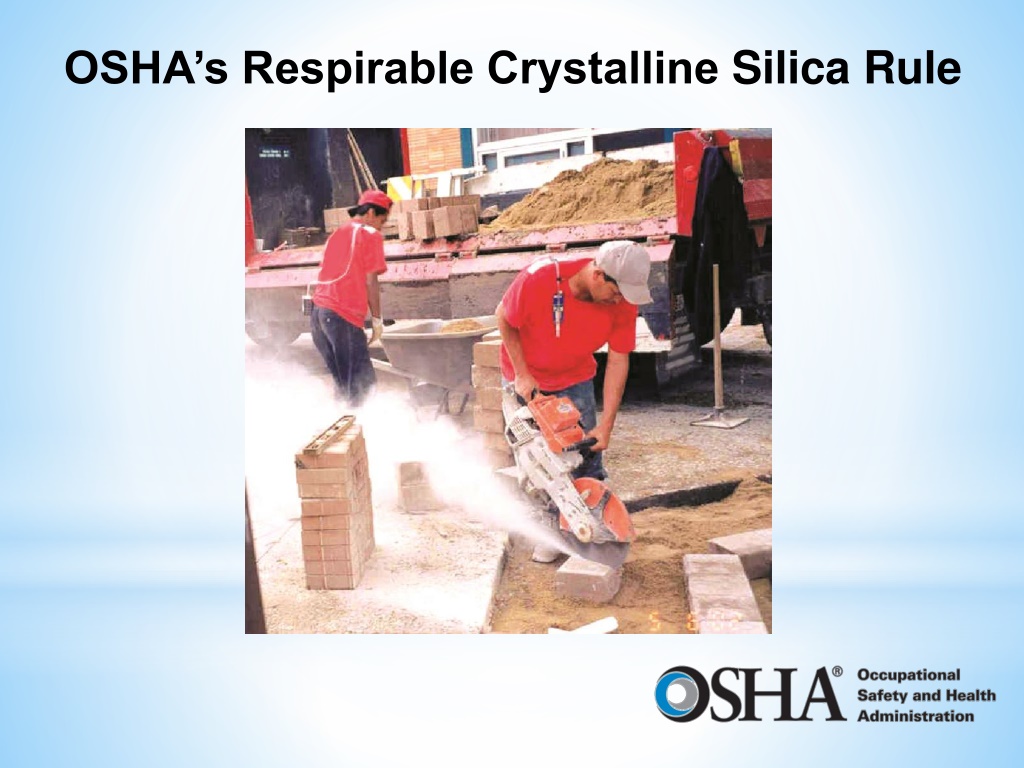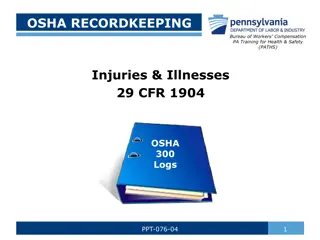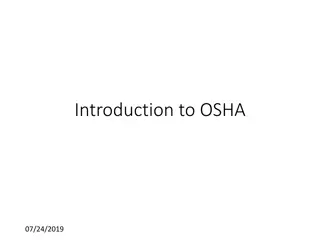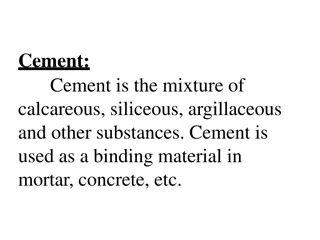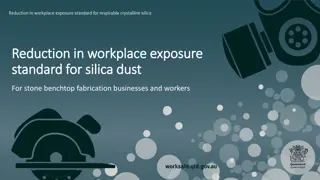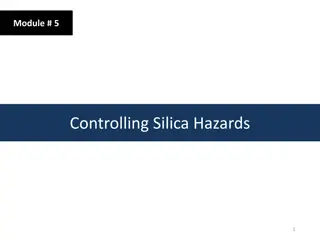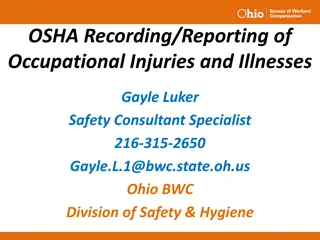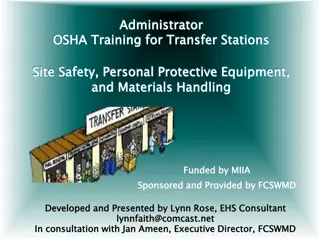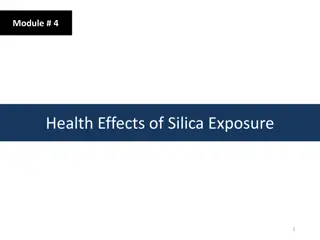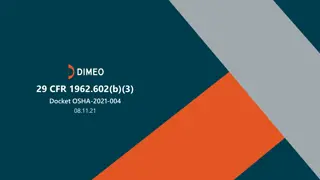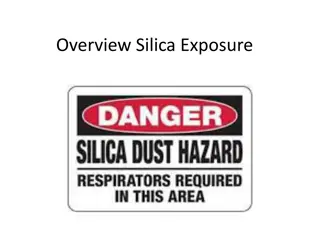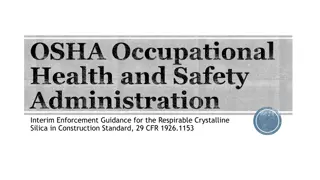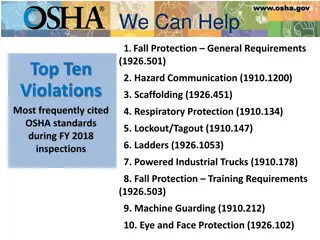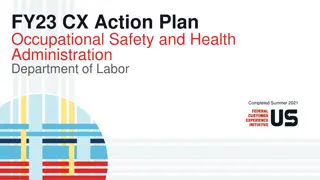OSHA's Respirable Crystalline Silica Rule Overview
Exposure to respirable crystalline silica can lead to serious health risks including silicosis, lung cancer, COPD, and kidney disease. The rule covers the scope of coverage, permissible exposure limits, exposure assessment methods, and requirements for construction sites. It emphasizes the importance of monitoring and controlling silica exposure through various control methods to ensure worker safety.
Download Presentation

Please find below an Image/Link to download the presentation.
The content on the website is provided AS IS for your information and personal use only. It may not be sold, licensed, or shared on other websites without obtaining consent from the author.If you encounter any issues during the download, it is possible that the publisher has removed the file from their server.
You are allowed to download the files provided on this website for personal or commercial use, subject to the condition that they are used lawfully. All files are the property of their respective owners.
The content on the website is provided AS IS for your information and personal use only. It may not be sold, licensed, or shared on other websites without obtaining consent from the author.
E N D
Presentation Transcript
Exposure and Health Risks Exposure to respirable crystalline silica has been linked to: Silicosis; Lung cancer; Chronic obstructive pulmonary disease; and Kidney disease 2
Scope of Coverage Three forms of silica: quartz, cristobalite tridymite Exposures from chipping, cutting, sawing, drilling, grinding, sanding, and crushing concrete, brick, block, rock and stone 3
Construction (a) Scope (b) Definitions (c) Specified exposure control methods OR (d) Alternative exposure control methods PEL Exposure Assessment Methods of Compliance (e) Respiratory protection (f) Housekeeping (g) Written exposure control plan (h) Medical surveillance (i) Communication of silica hazards (j) Recordkeeping (k) Dates 4
Permissible Exposure Limit (PEL) PEL = 50 g/m3 as an 8-Hour TWA Action Level = 25 g/m3 as an 8-Hour TWA 5
Exposure Assessment Required if exposures may reasonably be expected to be at or above action level of 25 g/m3 Exposures assessments must follow: The performance option The scheduled monitoring option. 6
Objective Data Includes air monitoring data from industry-wide surveys or calculations based on the composition of a substance; It demonstrates employee exposure associated with a particular product or material or a specific process, task, or activity. Must reflect workplace conditions closely resembling or with a higher exposure potential than the processes, types of material, control methods, work practices, and environmental conditions in the employer's current operations. 7
Scheduled Monitoring Option Prescribed schedule for initial and periodic personal monitoring If monitoring indicates: Initial below the AL: no additional monitoring Above the AL: repeat within 6 months Above the PEL: repeat within 3 months When two consecutive non-initial results, taken 7 or more days apart, are below the AL, monitoring can be discontinued Reassess if circumstances change 8
Employer shall maintain an accurate record of all exposure measurements and include The date of measurement for each sample taken; The task monitored; Sampling and analytical methods used; Number, duration, and results of samples taken; Identity of the laboratory that performed the analysis; Type of personal protective equipment, such as respirators, worn by the employees monitored; and Name, social security number, and job classification of all employees represented by the monitoring, indicating which employees were actually monitored. 9
Methods of Sample Analysis Employers must ensure that samples are analyzed by an accredited laboratory that follow specified quality control procedures Appendix A allows use of OSHA, NIOSH, or MSHA method for sampling and analysis 10
Construction - Specified Exposure Control Methods Table 1 in the construction standard matches 18 tasks with effective dust control methods and, in some cases, respirator requirements. Employers that fully and properly implement controls on Table 1 do not have to: Comply with the PEL Conduct exposure assessments for employees engaged in those tasks 11
List of Table 1 Entries Stationary masonry saws Handheld power saws Handheld power saws for fiber cement board Walk-behind saws Drivable saws Rig-mounted core saws or drills Handheld and stand-mounted drills Dowel drilling rigs for concrete Vehicle-mounted drilling rigs for rock and concrete Jackhammers and handheld powered chipping tools Handheld grinders for mortar removal (tuckpointing) Handheld grinders for other than mortar removal Walk-behind milling machines and floor grinders Small drivable milling machines Large drivable milling machines Crushing machines Heavy equipment and utility vehicles to abrade or fracture silica materials Heavy equipment and utility vehicles for grading and excavating 12
Example of Table 1 Entry Required Respiratory Protection and Minimum APF 4 hr/shift Equipment / Task Engineering and Work Practice Control Methods > 4 hr/shift Handheld power saws (any blade diameter) Use saw equipped with integrated water delivery system that continuously feeds water to the blade. Operate and maintain tool in accordance with manufacturers instruction to minimize dust - When used outdoors - When used indoors or in an enclosed area None APF 10 APF 10 APF 10 13
Example of Table 1 Entry Required Respiratory Protection and Minimum APF 4 hr/shift None Equipment / Task Engineering and Work Practice Control Methods > 4 hr/shift None Stationary masonry saws Use saw equipped with integrated water delivery system that continuously feeds water to the blade. Operate and maintain tool in accordance with manufacturer s instructions to minimize dust emissions. 14
Methods of Compliance Hierarchy of Controls Employers must use engineering or work practice controls to limit exposures to the PEL Respirators permitted where PEL cannot be achieved with engineering and work practice controls 15
Construction Written Exposure Control Plan The plan must describe: Tasks involving exposure to respirable crystalline silica Engineering controls, work practices, and respiratory protection for each task Housekeeping measures used to limit exposure Procedures used to restrict access, when necessary to limit exposures 16
Construction Competent Person Competent person is an individual capable of identifying existing and foreseeable respirable crystalline silica hazards, who has authorization to take prompt corrective measures Makes frequent and regular inspection of job sites, materials, and equipment Construction employers must designate a competent person to implement the written exposure control plan 17
Respiratory Protection Must comply with 29 CFR 1910.134 Respirators required: While installing or implementing controls or work practices For tasks where controls or work practices are not feasible When feasible controls cannot reduce exposures to the PEL 18
*Who is your Respiratory Program Administrator?
Respiratory Protection Program *Written program selection process *Level of the contaminant? *Medical evaluation *Fit test *Training *Recordkeeping
Housekeeping When it contributes to exposure, employers must prohibit: Dry sweeping or brushing Use of compressed air for cleaning surfaces or clothing Employer should use ventilation, HEPA vacuums, and wet sweeping. 21
Construction Medical Surveillance Employers must offer medical examinations to workers: Who will be required to wear a respirator under the standard for 30 or more days a year. Employers must offer examinations every three years to workers who continue to be exposed above the trigger Exam includes medical and work history, physical exam, chest X-ray, and pulmonary function test (TB test on initial exam only) 22
Medical examination continued: A chest X-ray (a single posteroanterior radiographic projection or radiograph of the chest at full inspiration recorded on either film (no less than 14 x 17 inches and no more than 16 x 17 inches) or digital radiography systems), interpreted and classified according to the International Labour Office (ILO) International Classification of Radiographs of Pneumoconioses by a NIOSH-certified B Reader; A pulmonary function test to include forced vital capacity (FVC) and forced expiratory volume in one second (FEV1) and FEV1/FVC ratio, administered by a spirometry technician with a current certificate from a NIOSHapproved spirometry course; Testing for latent tuberculosis infection; and Any other tests deemed appropriate by the PLHCP. 23
Medical Opinion Worker receives report with medical findings Employer receives an opinion that describes limitations on respirator use, and if the worker gives written consent, recommendations on: Limitations on exposure to respirable crystalline silica, and/or Examination by a specialist 24
Information provided to the PLHCP The employer shall ensure that the examining PLHCP has a copy of the standard, A description of the employee's former, current, and anticipated duties as they relate to the employee's occupational exposure to respirable crystalline silica; The employee's former, current, and anticipated levels of occupational exposure to respirable crystalline silica; A description of any personal protective equipment used or to be used by the employee, including when and for how long the employee has used or will use that equipment; and Information from records of employment-related medical examinations previously provided to the employee and currently within the control of the employer. 25
PLHCP's report for the employee A statement indicating the results of the medical examination, including any medical condition(s) that would place the employee at increased risk of material impairment to health from exposure to respirable crystalline silica and any medical conditions that require further evaluation or treatment; Any recommended limitations on the employee's use of respirators; Any recommended limitations on the employee's exposure to respirable crystalline silica; and A statement that the employee should be examined by a specialist (pursuant to paragraph (i)(7) of this section) if the chest X-ray provided in accordance with this section is classified as 1/0 or higher by the B Reader, or if referral to a specialist is otherwise deemed appropriate by the PLHCP. 26
PLHCP's written medical opinion for the employer shall be obtained within 30 days of the medical examination and contain: The date of the examination; A statement that the examination has met the requirements of this section; and Any recommended limitations on the employee's use of respirators. 27
If the employee provides written authorization, the opinion may contain Any recommended limitations on the employee's exposure to respirable crystalline silica; A statement that the employee should be examined by a specialist (pursuant to paragraph (i)(7) of this section) if the chest X-ray provided in accordance with this section is classified as 1/0 or higher by the B Reader, or if referral to a specialist is otherwise deemed appropriate by the PLHCP. the employer shall make available a medical examination by a specialist within 30 days after receiving the PLHCP's written opinion. 28
Communication of Hazards Employers required to comply with hazard communication standard (1910.1200) Address at least the following hazards: Cancer, lung effects, immune system effects, and kidney effects as part of HCS Train workers on health hazards, tasks resulting in exposure, workplace protections, medical surveillance, and elements of the standard. 29
Recordkeeping Must maintain records per 29 CFR 1910.1020 for: Air monitoring data Objective data Medical records 30
Brian Bothast Lead Safety and Occupational Health Specialist Peoria Area OSHA Office T 309.589.7033 oshapeoria@dol.gov
